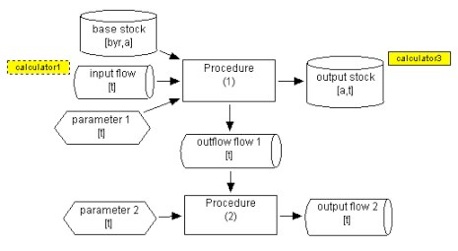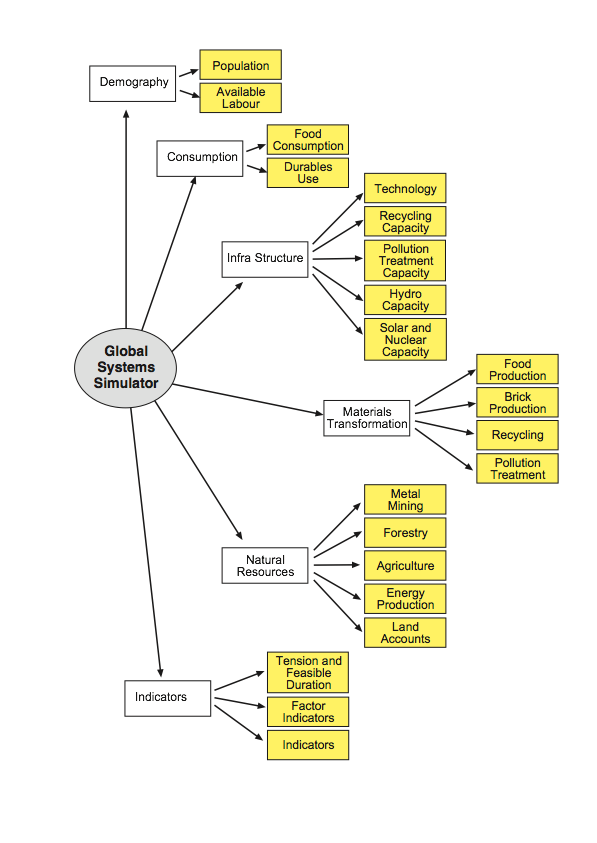Global Simulation System
a global scale, high granularity, stock and flow model


Global Simulation System
a global scale, high granularity, stock and flow model

The Global Systems Simulator (GSS) is a simulation model intended to illustrate some of the implications of the concept of sustainable development as it is applied to human ecology at the global scale.
In particular, GSS is a decision support tool for performing ’look-ahead’ analysis. It provides the means by which human society can explore the likely longer term consequences of collective societal actions before those actions are taken.

1.birth rate
2.life expectancy
3.food per capita
4.meat per capita
5.durables per capita
6.new recycling capacity
7.new pollution treatment capacity
8.investment in capital productivity research
9.investment in energy savings research
10.forest replanting
11.share of energy from wood burning
12.new energy production from solar/nuclear
13.new energy production from hydro
14.labour intensity by sector (8 of them)


modelling approach
The Global Systems Simulation is based on a world view that, simply stated, our world consists of two fundamentally different kinds of processes. First, there are processes that transform materials and energy. Some of these are naturally occurring and others are purposeful insofar as they have been put in place by human beings to meet the objectives of humanity. Second, there are processes that transform information and constitute what we might call a “mind-space”. It is the mind-space that governs the interface between the purposeful physical processes and our intentions.
What’s unique about this particular approach is that the model represents only the physical transformation processes and not the mind-space. In fact it is you, the user of the model who supplies the mind-space. The mind-space is the source of novelty and what human beings are good at is novelty. Human beings are capable of learning, and learning generates new insight which reconfigures the interaction between the purposeful physical processes and the context of naturally occurring processes.
tension
Because many external factors can influence one or the other process the coordination has to take place in real time. This is what the user of GSS is required to mimic as he or she attempts to resolve the tensions that arise, over time, in the simulation.
The problem domain addressed by this particular model is that of an exponentially growing population of people living on a finite planet. The planet provides the resources that sustain the population. The intermediary between the needs of the population and the resource base is the know-how or understanding that transforms those resources into the things like food, shelter, energy and mental stimulation etc. that are required to sustain the population. The model is designed in such a way to illuminate the tension between the needs of a population as it might evolve over time and the ability of the natural resource base to meet those needs.




NASA: sandstorm over Africa
NASA: lights in Europe
granularity and use of model
In order to create a useful model, the modeller always has to make tradeoffs between the scope of the model (time, space, and components to include) and the detail that is necessary to adequately represent the dynamics of concern. The term granularity is used to indicate the level of details that encompasses temporal and spatial resolution as well as the description of the model components and processes.
For example, if the model is considering Hydro Power capacity, does it deal with Gigawatts globally, regionally or at more detail? Does it consider the age distribution of the plants, and thus the life history of ageing plants and replacing them? Does it consider the capacity for further plants in terms of suitable areas, technology, materials and labour? As you can imagine these questions are highly pertinent to what kinds of questions the user of the model may wish to explore.
balancing complexity and detail
A major concern regarding the usefulness of a model is the capacity of the user. If a model is adequately detailed to address the kinds of questions the user is interested in, then the model is often so complex that the user must spend a substantial amount time working with the model in order to obtain the value it provides. This is contrary to the expectations of most policymakers, politicians, and the public. The attitude that a model should provide answers or even predictions is contrary to the real values. Namely a model is always an adjunct to human understanding. It enables people to expand their mental model.
Models are not intended to replace people.
GSS is designed for learning about sustainability concerns
The Global Simulation System is designed as a pedagogic version of a global overview. It requires the learner to spend adequate time playing with policies and seeing the consequences ripple through the system. Since it is explicitly designed not to provide answer, but rather to reveal the inconsistencies or “tensions” between polities in different sectors, it requires the learner to discover the reasons for the tensions and to find means of resolving them. Thus this model mimics the actual concerns that we must contend with if we are to resolve global scale issues.
A few of the variables that a user can manipulate are:

S.Kneebone unused draft fo Ison, Systems Practice
